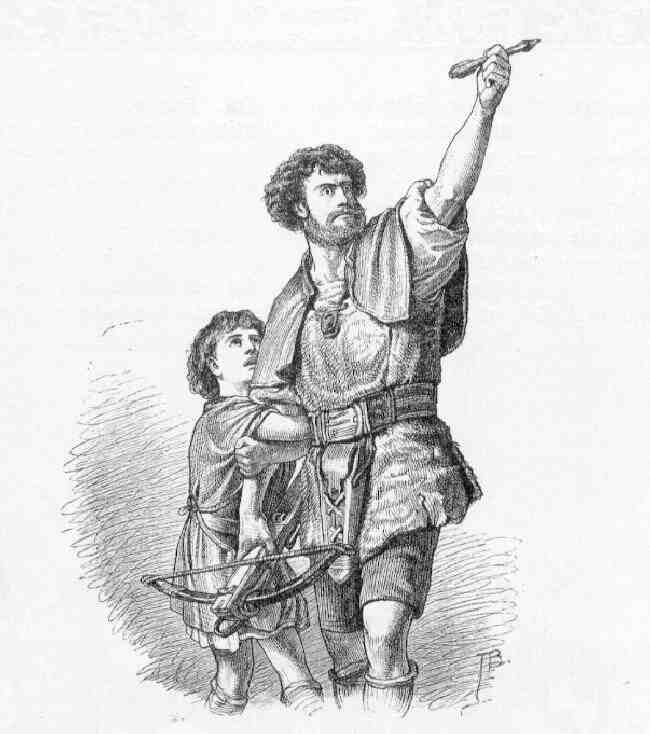
Costumes of Literary Characters: Switzerland

Figure 1.--This is an illustration from a compendium of Frederich Schiller’s works (1877). The William Tell incident is dated at about 1291. The depiction is thus historical. The clothing seems different from that in 13th century paintings. We are not sure if there were distibtive Swiss clothing in the 13th century. Perhaps our Swiss readrs will have some insights on this. I'm not sure who the illustrator was, but his initials are T.B. The caption in the book reads, "Tell says: 'With this second arrow I had shot – you, if I had hit my dear child”.
|
We know very flittle about Swiss literary characters at this time. The only Swiss book I know of is Johanna Spyri's Heidi. Of course Heidi is a girl. There is a goatheard named Peter in the story The book was written in German and can thus be classified in the German literary tradition. Of course a sizeable part of the Swiss population is German-speaking. There is one boy in Swiss folk lore daring from the 13th centuryy that is well known. He is the son of William Tell. At the time parts of Switzerland were under Austrian (Hapsburg) rule. The Austrian governor of a town made William Tell shoot an apple off his son's head when Tell angered the govenor. Most historians now believe that Tell is a fictitiius person,
but the story is set in the very real resistance to Hapsburg rule that gave rise to the Swiss Confederation.
The only Swiss book I know of is Johanna Spyri's Heidi. Of course Heidi is a girl. She is a healthy girl from the mountains who is taken from her grandfather. She changes the life of a a rich girl in the city. There is a goatheard named Peter in the story. Goatheard in German is "Geissenpeter" ("Geiss" is one of the German names for "goat", "Geissen" is the plural). The book was written in German and can thus be classified in the German literary tradition. Of course a sizeable part of the Swiss population is German-speaking.
Wilhelm Tell
There is one boy in Swiss folk lore daring from the 13th centuryy that is well known. He is the son of William Tell. At the time parts of Switzerland were under Austrian (Hapsburg) rule. The Austrian governor of a town made William Tell shoot an apple off his son's head when Tell angered the govenor. Most historians now believe that Tell is a fictitious person,
but the story is set in the very real resistance to Hapsburg rule that gave rise to the Swiss Confederation. The two most important literary depictions of the Tell story are by the drama by Friederich Schiller (German) and an opera by Gioacchino Rossini (Italian).
One of Schiller's great historical plays is “Wilhelm Tell” (1804). It is based on a Swiss national legend. The legend recounts how at the end of the 13th century Tell, a hunter living in Uri, was forced by the governor Geßler of the Habsburg possessions in Switzerland to shoot with his cross-bow at an apple put on the head of his son. Tell had refused to salute a hat of Geßler placed atop of a stick. Tell didn’t hurt his son; shortly after, however, Tell killed Geßler which became the signal for the rebellion by Swiss people against the Habsburgs. This is the historical origin of Switzerland as the Confederatio Helvetica.
This legend is a motive of many art works and also of Swiss stamps. The illustration here shows a depiction of this legend in a 1877 German compendium of Schiller’s works. This and other illustrations of the Swiss legend show interesting details of clothing of boys in the Swiss Alps in medieval times.
HBC

Navigate the Boys' Historical Clothing Web Site:
[Return to the Main literary page]
[Introduction]
[Activities]
[Bibliographies]
[Biographies]
[Chronology]
[Clothing styles]
[Countries]
[Movies]
[Contributions]
[FAQs]
[Dutch glossary]
[French glossary]
[Satellite sites]
[Boys' Clothing Home]
Created: 1:16 PM 5/7/2005
Last updated: 11:17 PM 5/8/2005



